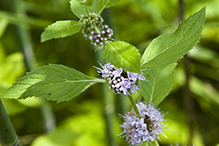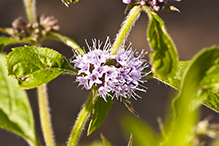wild mint
(Mentha arvensis)
Conservation • Wetland • Description • Habitat • Ecology • Use • Distribution • Taxonomy
Description |
||
Wild mint is a 4″ to 32″ tall, erect, perennial forb that rises from a rhizome and fibrous roots. It often forms colonies. The plant is highly aromatic and can often be detected by its minty odor before it is seen. The stems are erect or ascending and square. They are covered above the middle, especially on the angles, with both spreading, barely curved hairs and appressed, downward-pointing hairs. They are hairless near the base and often hairless between the angles. The leaves are opposite, broadly lance-shaped or egg-shaped, ¾″ to 3⅛″ long, and ¼″ to 1½″ wide. They are on short leaf stalks. They are wedge shaped at the base and taper to a point at the tip. The upper surface is hairless or nearly hairless. The lower surface is sparsely covered with short, soft hairs. Both surfaces are covered with minute, sunken glands. The margins are toothed except near the base with sharp, forward pointing teeth. When crushed, the leaves have a strong mint aroma. The inflorescence is a dense pair of branched, round-topped clusters of up to 20 or more flowers rising from the axils of opposite pairs of middle and upper leaves. The adjacent clusters form false whorls. The space between the nodes with flowers is about equal to the space between the nodes without flowers. The flowers are ⅛″ to ¼″ long. There are 5 green, hairy sepals (calyx) united for most of their length into a tube then divided into 5 short lobes. There are 5 white to light purple or pink petals, united for most of their length into a tube then divided into 2 lips. The upper lip is a single lobe with a notch at the top. The lower lip is divided into three, nearly equal lobes. The division of the corolla into two lips is not obvious, and the corolla has the appearance of having 4 regular lobes. There are four stamens of nearly equal length that protrude well beyond the corolla tube. The fruit is a smooth, light brown nutlet less than 1 ⁄16″ in diameter. |
||
Height |
||
4″ to 32″ |
||
Flower Color |
||
White to light purple or pink |
||
Similar Species |
||
| Spearmint (Mentha spicata) inflorescence is a spike-like cluster of flowers at the end of the stem. | ||
Habitat |
||
Wet to moist. Sedge meadows, calcareous fens, shores, streambanks, ditches. Full sun. |
||
Ecology |
||
Flowering |
||
July to September |
||
Pests and Diseases |
||
|
||
Use |
||
|
||
Distribution |
||||
|
Sources |
|||
| 7/17/2023 | ||||
Nativity |
||||
Native |
||||
Occurrence |
||||
|
||||
Taxonomy |
|||
| Kingdom | Plantae (Plants) | ||
| Division | Tracheophyta (Vascular Plants) | ||
| Subdivision | Spermatophytina (Seed Plants) | ||
| Class | Magnoliopsida (Dicots) | ||
Order |
Lamiales (Mints, Plantains, Olives, and Allies) | ||
Family |
Lamiaceae (Mint) | ||
| Subfamily | Nepetoideae | ||
| Tribe | Mentheae | ||
Subtribe |
Menthinae (balms, mints, and thymes) | ||
| Genus | Mentha (mints) | ||
| Section | Mentha | ||
In 1994, Flora of China observed that the North American plants classified as Mentha arvensis have a number of distinguishing features, including a higher number of chromosomes and a different leaf shape. It suggested that the native North American plants be segregated into a new species, Mentha canadensis. The change is controversial. In recent years there has been growing support for the name change, but it has not been universally accepted. Some botanists argue that the North American plants are still sufficiently similar to Mentha arvensis to warrant the same name. They also point out that the name change could cause confusion, as Mentha canadensis is already the name of a different species of mint that is native to eastern Asia. |
|||
Synonyms |
|||
Mentha arvensis ssp. borealis Mentha arvensis var. canadensis Mentha arvensis var. glabrata Mentha arvensis ssp. haplocalyx Mentha arvensis var. lanata Mentha arvensis var. sativa Mentha arvensis var. villosa Mentha canadensis Mentha gentilis Mentha glabrior Mentha penardii |
|||
Common Names |
|||
common mint field mint wild mint |
|||
Glossary
Axil
The upper angle where a branch, stem, leaf stalk, or vein diverges.
Calyx
The group of outer floral leaves (sepals) below the petals, occasionally forming a tube.
Corolla
A collective name for all of the petals of a flower.
Node
The small swelling of the stem from which one or more leaves, branches, or buds originate.
Rhizome
A horizontal, usually underground stem. It serves as a reproductive structure, producing roots below and shoots above at the nodes.
Visitor Photos |
|||||
Share your photo of this plant. |
|||||
| This button not working for you? Simply email us at info@MinnesotaSeasons.com. Attach one or more photos and, if you like, a caption. |
|||||
|
|||||
MinnesotaSeasons.com Photos |
|||||
Plant |
|||||
 |
 |
||||
Inflorescence |
|||||
 |
 |
||||
 |
|||||
Flowers |
|||||
 |
|||||
Leaves |
|||||
 |
|||||

Slideshows |
||

Visitor Videos |
|||
Share your video of this plant. |
|||
| This button not working for you? Simply email us at info@MinnesotaSeasons.com. Attach a video, a YouTube link, or a cloud storage link. |
|||
Other Videos |
|||
| Field Mint (Mentha arvensis) Wandering Sole TV |
|||
About
Published on Aug 15, 2013 Field Mint (Mentha arvensis), also known as Wild Mint, Corn Mint, or in the case of M. arvensis var. canadensis, Canada Mint. It grows and is native to the temperate regions of Europe, western and central Asia, east to the Himalaya and eastern Siberia, and North America. A member of the Mint (Lamiaceae) family, it can be used to make teas or jelly. Traditionally, it had been used to treat colds, pains, and swelling. The Nlaka'pmx peoples would place mint leaves around their dwellings to help ward off insect pests. Mentha arvensis grows in lower to mid-elevations, preferring wet seepage sites, the edges of wetlands, and lakeshores. |
|||
| "The Herb Guy" Wild Mint & Cattails KEVINNOAD1 |
|||
About
Uploaded on Aug 17, 2010 Picking Wild Mint & The many uses of Cattails |
|||

Visitor Sightings |
|||||
Report a sighting of this plant. |
|||||
| This button not working for you? Simply email us at info@MinnesotaSeasons.com. Be sure to include a location. |
|||||
| Karen Nelson 7/26/2020 |
Location: Onamia, MN Hello. We found some growing on our property. |
||||
MinnesotaSeasons.com Sightings |
|||||
Charles A. Lindbergh State Park Clifton E. French Regional Park Felton Prairie SNA, Shrike Unit Margherita Preserve-Audubon Prairie Mound Spring Prairie SNA, North Unit Northern Tallgrass Prairie NWR, Pavia Unit Northern Tallgrass Prairie NWR, Spieker Unit Pankratz Memorial Prairie, North Unit Pembina Trail Preserve SNA, Crookston Prairie Unit |
|||||

|
Created: Last Updated: © MinnesotaSeasons.com. All rights reserved. |
